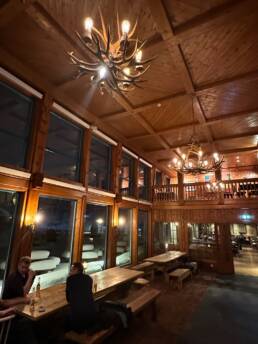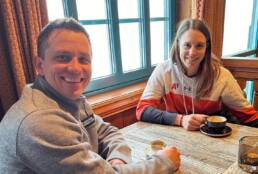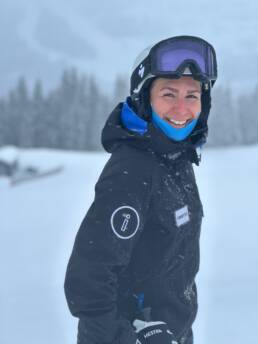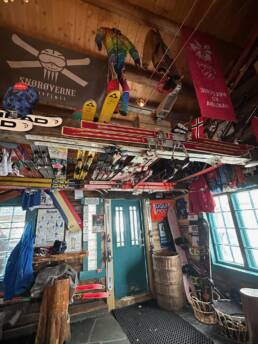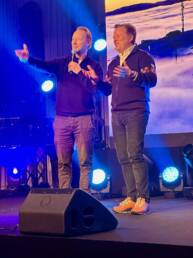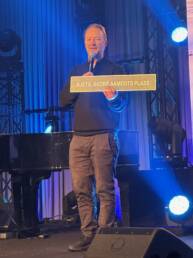It’s a powder day in Kvitfjell, high up in The Scandes, one of the world’s largest alpine ranges, with some of the steepest mountain faces on the planet. An overnight snowstorm has blanketed this Norwegian giant with a velvety cloak of white gold, and a bone-chilling late February wind has veiled most of the mountain in ghostly fog.
It’s a leap year Thursday, the 29th, the last on the calendar. For some a bonus day, full of spotless slopes ripe with fresh powder waiting to be tracked. But for others – the fastest women in the world on skis – it’s a day of waiting, as they prepare for the first World Cup downhill training run of the week on the famed Olympiabakken, the course that hosted the 1994 Winter Olympics thirty years earlier.
After an initial delay, the race jury, tasked with making the decision on whether we’ll have racing on this day or not, cancels the planned training run, giving Mother Nature the “W” due to poor visibility. But the cancellation of the first downhill run on the Olympiabakken doesn’t mean there won’t be skiing on this day, it’ll just be skiing of another sort, one that involves fatter skis, less talented skiers (at least in my case), delicious boot-deep Norwegian powder, and the distinct possibility of a few pitstops for lunch, and a few après rounds of Aquavit, a hyper-potent distilled spirit Norwegians have been coiffing for the last 600 years…but we’ll have more on that later on…please keep reading.
My first visit to Kvitfjell to watch the women race was supposed to happen in 2023, but a scheduling conflict on my part kept me from seeing history being made in person, as skier Kajsa Vickhoff Lie became the first Norwegian woman to win a World Cup downhill. Not only did Lie do this on home soil, she did it during the first World Cup women’s races ever held in Kvitfjell.
Having missed the amazing events of 2023, putting this fabulous week of racing at one of the most unspoiled and magical ski resorts around on my calendar was a no-brainer. Kvitfjell, whether you’re there to watch the world’s fastest men or women, is an unbelievable venue to get front-row access to World Cup ski racing, and you can even get there via train door-to-door from Oslo Airport. Unlike some of the races on the White Circus that draw massive crowds in the tens of thousands, Kvitfjell crowds are not overwhelming, and fans and athletes are only ever a few feet away from one another. It’s not uncommon to see the World Cup’s biggest stars mingling with spectators as they leave the race area, signing countless autographs for the throngs of kids who follow them around like Marvel universe superheroes.
Another reason to visit this year – the 30th anniversary of the 1994 Winter Olympics – and a star-studded celebration planned in accordance, an unforgettable evening of music, memories, and what turns out to be a hilarious, impromptu, stand-up-comedy-like appearance by one of Norway’s ski racing gods, the legendary Kjetil Andre Aamodt, who won silver in the 1994 Olympic downhill just 0.04 seconds behind American gold medalist Tommy Moe…but more on that later…let’s get back to powder skiing, starting with a quick ski-tourist-friendly bullet-point primer on Kvitfjell and its sister resort Hafjell, for those of you unfamiliar with these two wonderful resorts, or not old enough to remember the 1994 Winter Olympics:
Kvitfjell
- Kvitfjell Ski Resort is located in Ringebu, 2 hours and 40 minutes from Oslo by car. You can also take the train to Kvitfjell Station, and it stops right by a main ski lift. The resort has 34 km of alpine slopes, 600 km of cross-country trails, 2 terrain parks, and 2 dedicated children’s areas with a total of 14 lifts.
- Kvitfjell (which means “white mountain”) became a reality in connection to the 1994 Lillehammer Winter Olympics, and the downhill and super-G competitions for ladies and men were held here.
- Kvitfjell has three mountain sides – the East side hosts the World Cup races and has one of the longest steep black runs in existence, the West and Varden sides have great family slopes and an off-piste “Powder Forest” that is a real treat!
- There are dining locations and après-ski on all three sides, a ski school, sports shop, ski rental, grocery shop, and even an on-mountain deli!
Hafjell
- Norway’s third largest ski resort, Hafjell has 18 lifts and 54 kilometers of slopes, and over 600 km of prepared cross-country trails. It’s less steep than Kvitfjell, and has a more family-friendly vibe in terms of ski terrain.
- Hafjell is located 2 hours away from Oslo by car. You can take a train to Lillehammer and a bus that connects you to the resort.
- In 2020, Hafjell was the host of the X Games Norway with Slopestyle and Big Air events.
- Like Kvitfjell, in Hafjell you’ll find a ski school, sports shop, ski rental and groceries.
- In Øyer, which is the municipality Hafjell is located in, you can find all kinds of shops, pharmacies, beer and wine outlets, sports stores, a library, restaurants, family and amusement parks, swimming facilities, bobsleigh and toboggan tracks, and a sea of hiking areas.
- 15 minutes south of Hafjell is the town of Lillehammer, (official host town of the 1994 Olympics) with just about everything a ski tourist will need in terms of shops and shopping, museums and cultural offerings, food and dining places, and even a cinema.
Both Kvitfjell & Hafjell are known for their reliable ski conditions, with long seasons that usually begin in November and end in April. With many resorts in Central Europe and North America struggling for snow this winter, I’m immediately struck by the superb conditions, and ample coverage as I walk out the door of the palatial Gudbrandsgard Hotel to put on my skis after receiving notice the first downhill training run of the week has been canceled.
The Gudbrandsgard, a majestic, dark log, ski-in/ski-out hotel located at mid-mountain on the Eastern face of the resort is perched on a slope directly overlooking the Olympiabakken downhill track. A super-sized Scandinavian longhouse disguised as a luxury hotel, spa, and conference center, The Gudbrandsgard is home to the best skiers in the world, and an assortment of others (like yours truly) during World Cup race weeks, and to ski holidaymakers when the White Circus is not in town.
At the very heart of the Gudbrandsgard is a stately long hall, with huge panoramic windows, and a towering wood-paneled ceiling with vintage reindeer antler chandeliers. A hive of activity during the day with racers, coaches, officials, and a sprinkling of ski journalists milling about, this striking space turns into a World Cup Valhalla of sorts as the sun sets and night shrouds the mountain in darkness. A spectacular example of Viking-inspired traditional interior design, the Gudbrandsgard’s long hall will haunt your ski holiday dreams forever, the soft golden light of the chandeliers, the clinking of glasses toasting into the night, and the voices of skiers regaling each other with tales of glory on Kvitfjell’s snowy steeps echoing into the night.
My ski guide on this day is Veslemøy Eineteig Wedum, a badass local skier with a shock of tightly cropped, short blonde hair, and the steely gaze of a Viking shield-maiden ready for battle. When Wedum, who grew up ripping in Hafjell and Kvitfjell, is not busy looking like she just walked off set of the television series Vikings, she’s usually busy working as Head of Communications for Alpinco, the company that owns and operates the Kvitfjell/Hafjell resorts, as well as the Gudbrandsgard Hotel. After a few powdery laps on the east side of the resort not far from the race course, I ask Wedum how she ended up working at one of the most beautiful ski resorts in Europe. Her answers make it more than clear that this is not just a day job for her, it’s a lifelong love affair with skiing, and the mountains she’s called home forever.
“I started working in Hafjell when I was 15 years old. Back then, I worked at one of the resort’s old restaurants serving hamburgers and fries. In the evening I cleared beer glasses at the après-ski bar,” Wedum tells me as we’re riding up a chairlift after confessing she even got to dress up as a troll and a mascot during the 1994 Lillehammer Winter Olympics opening and closing ceremonies.
“We were a whole bunch of neighborhood friends who all worked here during the winters, exclusively to get access to season passes and lots of time on skis! I grew up 500 meters from the ski slope, and after school, we always went here for night skiing, saving our school lunch pack to eat as an evening meal after skiing. So it’s quite nostalgic for me to work here now as a communications manager, and to talk to guests about everything Kvitfjell and Hafjell have become today since the start and the Olympics in 1994,” she adds with a wistful smile.
As we go higher up the mountain, Wedum asks me if I’d like to see one of Kvitfjell’s coolest locations, Pudderskogen (The Powder Forest), an entire section of the mountain devoted to off-piste tree-skiing. I can tell Wedum’s stoke level has become elevated as she tells me about this fab new spot, and it’s not long before it becomes clear why – she’s the one who named it – winning a company-wide naming contest.
“Three years ago, we opened up a new area for off-piste, Pudderskogen/The Powder Woods. It’s on the Varden side of the mountain, the newer third side of the resort, and is north-facing so it’s climatically inclined for a ton of powder snow that seems to stay fresh all season. When Alpinco announced a naming contest, I submitted my suggestion and I won the competition with the name Pudderskogen. A fitting name that I am very proud of today, especially when I see the cool carved wooden Pudderskogen portal gate as you enter it and go to powder heaven,” Wedum says energetically.
A few hours later, happy as a clam from shredding real Norwegian Pow in a real Norwegian Wood, I pull the needle off the Beatles tune playing in my head, and ask Wedum where the best place to get a drink on the mountain is, as après time is nigh.
“That’s pretty simple, Koia Kvitfjell is THE PLACE to for après here, and trust me when I say it’s going to blow your mind, it’s part bar, part insanely cool ski memorabilia museum. It even has Mikaela Shiffrin’s downhill suit from the 2023 Kvitfjell World Cup hanging from the ceiling,” Wedum says.
Intrigued – and full disclosure I’m a known ski memorabilia nerd who even has a champagne cork Canadian Cowboy John Kucera popped on the podium after winning a World Cup Super-G at Lake Louise in November 2006 – I agree to visit this museum of ski racing wonders that also serves Norway’s most beloved distilled spirit Aquavit.
Inside Koia, I’m overcome by the sheer amount of amazing ski racing memorabilia hanging all over the walls and ceiling. Everything from 1994 Winter Olympics opening and closing ceremony costumes, vintage race bibs, skis, helmets and ski jackets belonging to the greatest downhillers in Norwegian alpine racing history is here – and as advertised – Mikaela Shiffrin’s super sick downhill suit from the 2023 Kvitfjell World Cup is also on display. After a nice warm up by an open fire, a million photos and videos, and couple of hair-on-the-chest-adding Aquavit shots, I thank Wedum for a most excellent day on the slopes, and for my introduction to one of THE COOLEST ski bars I’ve ever had the good fortune of walking into and bid her “farvel” as they say in Norway.
A quick 200-yard ski later, I’m back at the very conveniently located Gudbrandsgard hotel where I partake in an extremely refreshing spa session before heading out to a glitzy gala dinner the Kvitfjell race organizers put on for the hundreds of volunteers, without whom World Cup racing wouldn’t happen. After being mistaken several times for Bruce Springsteen pal & guitarist Steve Van Zandt, I realize it’s time to go to bed, and not to take the comparison to the Sopranos and Lillehammer actor personally as Norwegians are by their very nature, really, really, really nice people who would never dream of insulting me…but I digress.
Friday morning is a replay of Thursday; more fog, snow, and wind creating brutal visibility. It’s more than clear Mother Nature is not playing ball with the FIS, and the tireless Kvitfjell World Cup race organizers and volunteers hoping to get a downhill training run in so the women can race on Saturday. After several postponements, DH Training 2 is called off, and thus no downhill race on Saturday.
All is not lost however, as weather conditions are supposed to be better on Saturday and Sunday. With a positive forecast on the horizon, the powers that be decide to hold a make-up Super-G on Saturday (replacing a canceled race at Val di Fassa, Italy) and to race the originally scheduled World Cup Kvitfjell Super-G on Sunday.
I celebrate the good news with another powder session, and then attend a press conference held by one of Norway’s greatest female alpine ski racers Ragnhild Mowinckel, who is announcing her retirement after a stellar career (14 World Cup podiums including wins in three disciplines – Downhill, Super-G, and Giant Slalom, as well as 2 Olympic silver medals) in the afternoon.
That evening, after another late afternoon spent lingering in the Gudbrandsgard’s luxurious hotel spa facility, I have dinner with a few Norwegian colleagues and friends in the hotel, and make an early night of it, as Saturday will be a day at the races!
Saturday’s World Cup Super-G race goes off with a hitch, with a huge crowd of very excited ski racing fans, many of them waving Norwegian flags, on hand to watch the women crush the Olympiabakken course. The finish area has a vibrant festival feel resembling a state fair, with music, food, shopping, and the joyful sound of families enjoying the splendor of winter high up in the mountains of Norway. As race time approaches, attention quickly turns to the track, and the crowd focuses on 48 of the fastest women in the world, risking life and limb at high velocity for sporting glory. At the end of the day, 2024 Overall World Cup Crystal Globe winner Lara Gut-Behrami skis a near perfect run to take top spot, with Austrians Cornelia Huetter and Mirjam Puchner in second, and third respectively.
As darkness approaches, and the race area clears, a ceremonial flame is lit near a large white tent that’s been hosting Summit Kvitfjell, a two-day “national business conference on snow” that’s kind of like a Norwegian TED Talk focussing on innovation and inspiration with world class ski racing as a backdrop. But on this night sport is the focus, and the who’s who of Norway’s ski racing world, from federation officials, to event organizers, to sponsors, to volunteers are gathered together to commemorate and celebrate the 30th anniversary of the 1994 Lillehammer Winter Olympics in a 90-minute multimedia concert blending cinema and live music from some of Norway’s most popular musical icons.
Once the audience is seated, the lights go down, and the screen flickers on to a jaw-droppingly gorgeous panoramic shot of a lone pianist in ski gear playing a frost-covered, jet black grand piano on Kvitfjell’s snowy peak. The tune is very familiar to Norwegians, as is the musician playing it, Dag Kolsrud, one of Norway’s most beloved musical artists and composers, who was the man behind the music for the 1994 Lillehammer Winter Olympic Games. As the camera does a 360 degree move around Kolsrud, the audience erupts into a roar of applause, overwhelmed by the beauty of Kvitfjell in the sun, perched high above an ocean of clouds anchored by an endless bluebird sky, and the heartwarming soundtrack they first heard 30 years earlier.
As the show progresses, the audience is clearly moved by the mix of traditional and modern music they hear accompanying cinematic highlights from the 1994 Olympics, reliving some of Norway’s most glorious memories from those games. But the evening, billed as “30 years in 90 minutes” by organizers is also a retrospective of what the Olympics did for the area, especially the growth and development of Kvitfjell.
After an emotionally moving highlight reel of Norwegian World Cup victories at Kvitfjell over the last 30 years, Arne Fossmo, the mayor of Ringebu, the municipality the mountain sits in reminds the audience of an important fact: No Olympic Games in 1994 – no classic World Cup races in Kvitfjell.
When Bente Bjørnsen Sherlock, a fellow journalist sitting next to me asks what my impressions are mid-show, I reply as honestly as I can, and admit, “I’m not Norwegian, but after seeing these images and hearing this incredible music, I feel like I am!”
Just as I finish professing my excitement over my new-found inner Norwegian soul, the MC, Arne Hjeltnes, brings the top racers skiing in Sunday’s Super-G onto the stage to announce their bib numbers. Not long after, the night’s most hysterically funny moment takes place as one of Norway’s greatest alpine ski racing giants – Kjetil André Aamodt – is welcomed onto the stage along with Ringebu Mayor Arne Fossmo for a special surprise presentation.
Aamodt, one of Norway’s most decorated alpine champions (21 World Cup victories – with at least one in each of the five disciplines, 5 World Championship golds, 4 Olympic golds, and an overflowing treasure trove of other Olympic, World Championship and World Cup 2nd, and 3rd place finishes) is more than just a Norwegian ski legend, he’s in the pantheon of global alpine ski racing gods. Still, even gods can have an off day, and before long Aamodt begins a gut-bustingly hilarious self-deprecating self-roast of sorts as he’s asked by Hjeltnes about his memories from the 1994 Olympics.
My understanding of Norwegian is rudimentary, but Aamodt’s message has a distinct, “You win everything there is to win everywhere in the world of ski racing…but you get silver in one race, and that’s what they remember you for!” vibe to it.
With the timing of a Jerry Seinfeld, and the dry wit of a Bill Murray, Aamodt has the audience rolling in the aisles with a deadpan account of that fateful day in 1994 he lost Olympic downhill gold to American racer Tommy Moe by 4/100s of a second on home soil (writer’s note: Tommy Moe was a great racer…but by no means a ski racing god, and I’m sure even Tommy would agree with that).
Part of Aamodt’s sidesplitting Rodney Dangerfield “I get no respect” bit includes an observation about the sections of Kvitfjell’s Olympiabakken race course named after famous skiers and the people behind the creation of the track. Aamodt rattles off the names, pointing out with a pained look on his face, how Tommy Moe got a section named after him for winning gold in the downhill. How Swiss downhill legend Bernhard Russi had a big jump titled in his honor for designing the course. How Norwegian downhill rockstar Kjetil Jansrud got a jump named after him after he retired, and even how former Ringebu Mayor Erik Winther got a section named in his honor for giving course builders the green light to chop down a bunch of trees.
At this point Mayor Arne Fossmo takes over the mic, and with a straight face makes a series of remarks that continue to kill the audience. But before long the tone changes, and it’s clear the mayor is there to honor Aamodt, with the announcement that Kvitfjell’s finish area will from now on be known as “Kjetil André Aamodt Plass” and the Norwegian legend is awarded a plaque bearing his name, and it’s new geographical designation.
As the evening comes to a close, and one of the volunteers extinguishes the torch flame lit in finish area, which is from this night on forever be known as Kjetil André Aamodt Plass, I realize how lucky I am, to be treated like family by one of the warmest and friendliest alpine skiing communities on the planet, during a week that means so much to them.
Driving back up Kvitfjell’s winding switchback road to the Gudbrandsgard Hotel to spend one more night on Norway’s most famous “white mountain” on the eve of the weekend’s last Super-G race (won by Federica Brignone of Italy btw), I ask a Norwegian friend how to say thank you? She tells me the best way is to say, “Tusen Takk” which means “a thousand thanks” – which works perfectly for me as that’s exactly how I feel at this very moment, thankful a thousand times over!
Related Posts
Nothing found.







